4 ways to teach Mindfulness to your Students
30th December 2021
With courses for child counselling becoming so popular, teaching mindfulness in the classroom has become a necessity in recent times. Teachers and parents as well as children all around are stressed and anxious. Our lives are getting complicated and we often find ourselves reminiscing over the past or worrying about the future. Mindfulness has become such an important part of our lives more so because it trains our minds to live in the present moment, enjoying and experiencing what’s in front of us.
“I always like to start or end counseling lessons with mindfulness exercises. Keeping the activities consistent while giving them fun themes helps kids feel a sense of mastery over the activities while also keeping their interest-” Unknown
As educators well-acquainted with school counselling techniques, know that children learn best when they are comfortable, safe, and relaxed. This kind of learning environment allows them the gift of lifelong learning and the tools to become kind and productive adults, as well as they are bestowed with the gift of mindfulness too -- using their breath and mind to lead a happy and healthy life. This also has benefits for the teachers – the teacher will find satisfaction while teaching and we all know that a happy teacher has a happy classroom.
4 Easy Mindfulness Activities
Mindfulness Through Movement
Humans are born to move. The movement comes naturally to us; however, it has become a luxury in modern times. Try introducing movement into your classroom; this will allow your students to get the most out of their natural way of learning. Yoga is a simple exercise that you can utilise for adding movement to your students’ school day. Children can use yoga to develop their self-expression and self-confidence. Provide opportunity to your students to practice yoga in their chairs, or outside.
Mindfulness through Breathing
Make ample use of printable breathing guides like real leaves that can help students practice controlled breathing. They can practice inhaling and exhaling as they trace the edges of the leaves with a finger.
Mindfulness through Guided Imagery
Guided imagery is another medium that helps in the effective development of children's imagination. It also helps to incorporate learning with prior knowledge. Here’s an example: when you start a new topic in your classroom, have your students close their eyes (if that's comfortable) and tell stories related to the topic that you are teaching. Hence, if you're studying the ocean, have them imagine getting into underwater vehicles and cruising through the ocean waters, looking for fish, animals, and plants.
Mindfulness through Sensory
Young students love homemade scented play dough, and flour play-dough with a few drops of vanilla/strawberry essence is perfect for the season! Squeezing, smashing, and moulding the play dough is a great sensory activity, and the scents are a bonus. Prompt students to describe the sensations in their palms and fingertips.
Help them make play-dough with this recipe:
- Ingredients:
- 1 cup flour
- 1/4 cup salt
- 1 tsp cinnamon
- 1 tsp nutmeg
- 1/2 tbsp oil
- 1tsp essence of your choice
- 1 tsp red food coloring (optional)
- 1 cup water
- Instructions:
- Combine dry ingredients
- Add wet ingredients
- Mix well and form various shapes
- Color them if you want to and let the children play!
Written By : Anindita Das